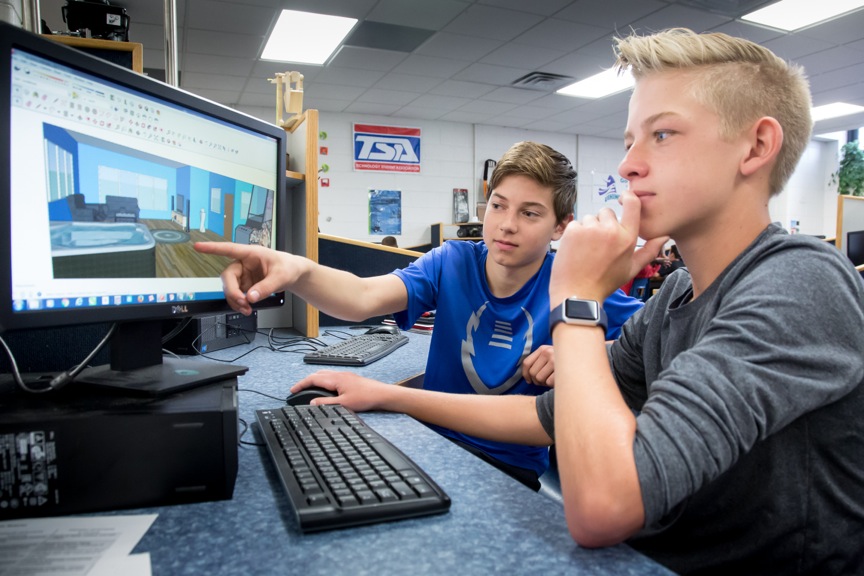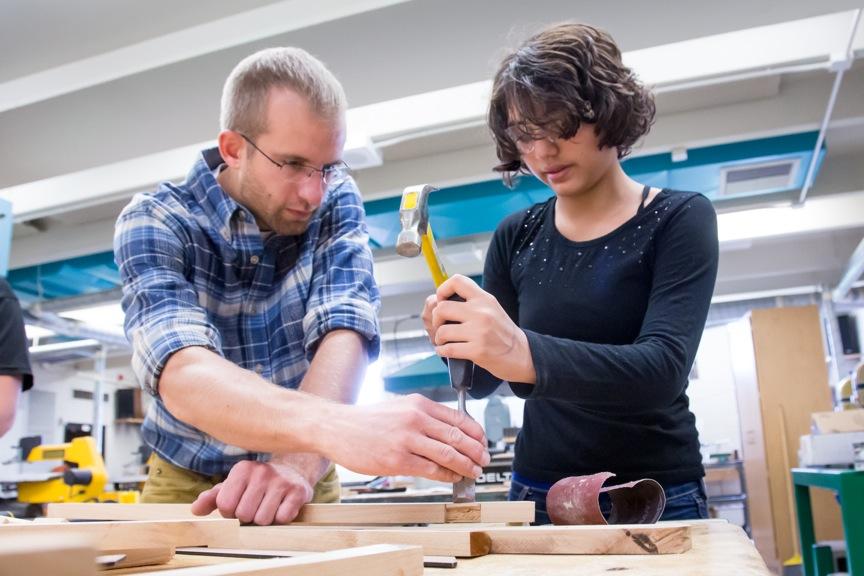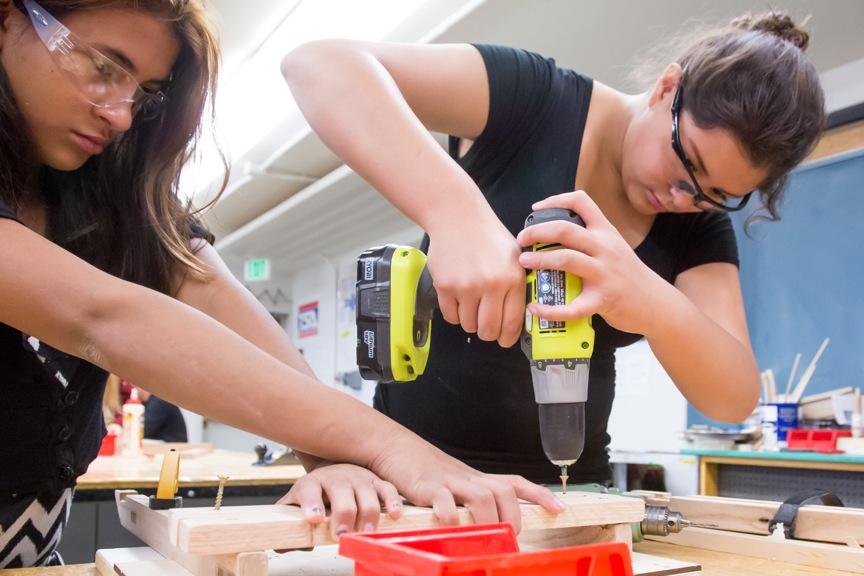Goddard Middle School Showcases District Commitment to Middle School STEM Experience
Goddard Middle School Showcases District Commitment to Middle School STEM Experience

When students Morgan Schilling and Jaden Steffen had a chance to digitally remodel their cafeteria at Goddard Middle School, they went big. “We added a hot tub, a pop-a-shot game, a big screen TV and a lounge couch to the cafeteria…perfect for chilling during lunch!” said Morgan, an 8th grader enrolled in the Science, Technology, Engineering and Math (STEM) program. “Our teachers give us a lot of freedom for creativity, and they let us figure out the best way to do things. It’s really cool.”
This STEM design/build project, one of several assigned each semester, included interviewing students to get their ideas on what would be a good use of the old lunch space, as well as creating a 3-D computer model of the room using Google Sketchup software. The students then add details like flooring materials, paint and furniture (even a hot tub) to their design. They calculate the building costs based on item pricing and a per-square-foot formula. Their final designs are shared with other students through Google Presentation. Last year the 8th grade class designed Tiny Houses (based on the HGTV series of the same name) and created models of their little houses using 3D printers from the STEM computer lab.
The Goddard STEM program is available to all three grades and consists of two separate classrooms, one housing traditional woodworking equipment, and the other a contemporary computer lab. While the two areas are strikingly different (think sawdust and hammers next door to computer workstations and a laser engraver), the combination works.
Elijah Hoffman, an eighth grader in his second year of STEM classes, contrasted the two areas as “the computer room is for our heads, and the woodshop is for our hands.”

(Goddard teacher Erik Nygren assists student Elena Roacho with a STEM project)
The Goddard STEM teachers, Dan Steepleton and Erik Nygren, are constantly looking to blend the kinesthetic cutting, sawing and gluing of the woodworking area with the cerebral software design tools in the computer lab. “We aren’t a traditional woodshop class, and we aren’t a tech-ed class – we are trying to integrate the two with our projects. We get to teach the kids a little bit about a lot of things…with a goal of helping them find something they enjoy and will continue to study in high school,” said Steepleton.
“The kids learn computer coding skills, graphic design skills, as well as tool use and hands-on building in the woodshop. We are heavy into math with the 6th graders as they build their trebuchets, so by the time they are in 8th grade they have the math necessary for calculating construction costs as part of the design project,” said Nygren.
Evoni Gamble has been in the STEM program for 3 years. “When I started I wasn’t very good at this stuff – I didn’t know the tools or how to make things. Seventh grade was better, and now in 8th grade the projects are really awesome.”
With over 250 kids coming through Goddard’s STEM labs every day, the program has a big influence on the school. Steepleton and Nygren work to integrate the STEM message into other programs. “We might be working on how to calculate the area of a work space with the STEM students, and I can tie that to what Mr. White is doing in Math next week. This way it’s not a stand-alone curriculum but all encompassing for the building. And that’s important.”

(Middle school students Melissa Pantoja Martinez and Alycia Puentes put their STEM knowledge to work in the Goddard lab)
The groundwork to bring STEM to Littleton Public Schools’ students has taken vision and a lot of patience. In the early 1990’s, LPS was building “tech labs” when other districts were eliminating their wood and metal shops altogether. “When LPS asked us to help with the STEM concept five years ago, we were the only school district in the state that still had functioning shops in all of our middle schools,” said Beth Best, Executive Director of the Littleton Public Schools Foundation. “Our vision was that we didn’t want a STEM program that pretends to be STEM, we wanted it to be the complete program.”
The Foundation subsequently raised $600,000 to fill those spaces with high-tech components like laser engravers, CNC router machines, 3-D printers and state-of-the-art computers. “The Foundation is very proud of the community partnerships that generated that funding, and we’ve worked hard to level the playing field across the district for the kids – you can walk into any STEM class in LPS and you’ll find students from all backgrounds working side by side, peer-teaching each other with these amazing tools.”
LPS values STEM for all students. Rather than providing STEM to a limited number of students in a magnet school setting, STEM is offered in all LPS elementary, middle and high schools. The experiences in Goddard’s STEM lab are replicated in all LPS middle schools. They include design/build in areas of aerospace, aeronautics, engineering, robotics, bridge design, architecture, CO2 dragster design, video production, digital photography, computer animation, laser applications, CNC mill, desktop publishing, audio production, 3D design, graphic design, engine design, woods/metal technology and 3D printing. Every year, hundreds of LPS middle and high school students compete in the Technology Student Association at the state and national levels and bring home top honors.
“The STEM program emphasizes the need for including the high-tech tools with traditional tools,” said Steepleton. “We talk with teachers in other districts that are scrambling to piece together a shop, and we are so fortunate that the Foundation came and helped us with the hardware…what we have here is remarkable.” Nygren added, “We had visions of what we wanted this STEM program to be like, but most of what we have would never have happened without the support we’ve received from the Foundation. Their fundraising efforts have been absolutely instrumental in getting the program to where it is now,” said Nygren.
Summarizing the advantage that the Foundation has given the STEM efforts at Goddard, Nygren said, “Instead of having to build projects with marshmallows and straws that eventually go in the garbage, our kids can design their project on a computer, cut it with a laser and build it in the woodshop and have a tangible, visible end product.”
Whether it is building with their hands or using their minds to design, the outcomes are limitless – including a middle school cafeteria with its own hot tub.
(Featured photo: Students Morgan Schilling and Jaden Steffen work on a digital remodel of the Goddard cafeteria in the school’s STEM program.)
Article and photos courtesy of Bill Youmans, writer & photographer
